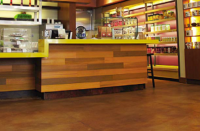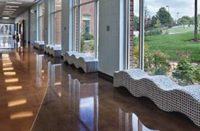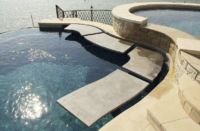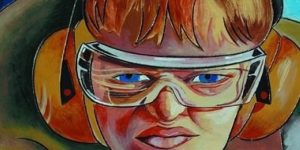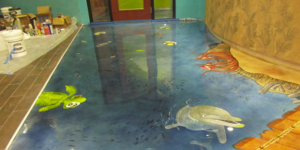
Architects and designers working on the construction of the new Potawatomi Executive Building developed an elaborate stained-concrete floral pattern for the rotunda floor.
Shawn Wardall is a gardener of sorts. This summer he coaxed flowers to bloom in concrete, much to the delight of the Potawatomi tribe at the Forest County Potawatomi Reservation near Crandon, Wis.
 Last fall, the architects and designers working on the construction of the new Potawatomi Executive Building developed an elaborate stained-concrete floral pattern for the rotunda floor.
Last fall, the architects and designers working on the construction of the new Potawatomi Executive Building developed an elaborate stained-concrete floral pattern for the rotunda floor.
The design was a very important aspect of what the tribe wanted for the project, because it had sacred meaning to their heritage. Eugene Shawano, tribal administrator of the Forest County Potawatomi, says the floral design was the kind of design the woodland Indians used in their beadwork. As compared to motifs used by American Indians in the southwest or plains states, these floral designs reflected nature in the Potawatomi’s environment.
 The problem the architect had was finding someone who could actually make the floor a reality, since decorative concrete artisans are not in great supply in northern Wisconsin. So they asked the advice of the folks at L.M. Scofield, who recommended Wardall for the job.
The problem the architect had was finding someone who could actually make the floor a reality, since decorative concrete artisans are not in great supply in northern Wisconsin. So they asked the advice of the folks at L.M. Scofield, who recommended Wardall for the job.
Due to construction delays, Wardall didn’t get to start until July, when he and his crew created the concrete garden in two weeks time. While waiting for the OK, he took care of the preliminary work, including working with a sign company to manufacture the design templates out of stencil material. “The floral design included flowers, vines and leaves on a field color, and I worked with a 10-color palette of greens, blues, yellows and browns,” Wardall says.
Wardall made test pieces for approval, but when he got on site he found that he had five different shades of gray to deal with on the concrete floor, due to the different sections being poured at different times and not always with the same mix design. The field color instantly became a challenge. New sample boards were made and approved, and most of the stains he used needed to be customized on site to match. “There were a lot of red hues in the floor. We wound up having to add blue to offset this effect in just about every color we used,” he says.
 The stencils Wardall had made were large enough that he didn’t have to peel and stick them to the floor, giving him flexibility to move them around and make adjustments. He then traced the pattern with chalk, used a 4-inch grinder to make his saw cuts, and “from there it became a large paint-by-numbers.”
The stencils Wardall had made were large enough that he didn’t have to peel and stick them to the floor, giving him flexibility to move them around and make adjustments. He then traced the pattern with chalk, used a 4-inch grinder to make his saw cuts, and “from there it became a large paint-by-numbers.”
“I thought about this job for six months and completed it in my head a hundred times,” Wardall recalls. And he had prepared for any possible situation to crop up — after all, you won’t find a local decorative concrete supply store in the Wisconsin north woods.
 The result was a flower garden in concrete that even the best “real gardener” would be proud of. Shawano says initially the floor was going to be made of another material, but he is glad the tribe went with concrete. “We didn’t realize how decorative you can get with concrete,” he says. “When you look at tile, carpeting [or other flooring materials], you don’t get the opportunity to lay out your design as well as with concrete.”
The result was a flower garden in concrete that even the best “real gardener” would be proud of. Shawano says initially the floor was going to be made of another material, but he is glad the tribe went with concrete. “We didn’t realize how decorative you can get with concrete,” he says. “When you look at tile, carpeting [or other flooring materials], you don’t get the opportunity to lay out your design as well as with concrete.”
 And, Shawano points out, you can be real specific in what you want or need. “Most people think concrete is white or gray, or sidewalks, and don’t think of it being something to create artwork on.” In the case of the Potawatomi’s rotunda floor, not only do they have beautiful artwork, it has special meaning to the tribe and is educational, too.
And, Shawano points out, you can be real specific in what you want or need. “Most people think concrete is white or gray, or sidewalks, and don’t think of it being something to create artwork on.” In the case of the Potawatomi’s rotunda floor, not only do they have beautiful artwork, it has special meaning to the tribe and is educational, too.
